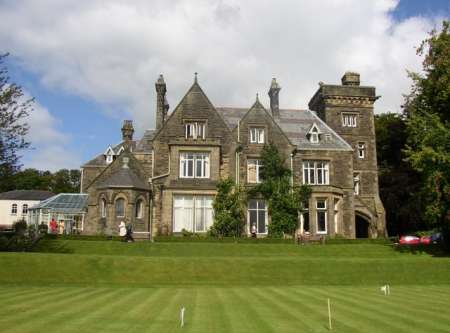Alston Hall Alston near Longridge
Picturesquely sited on the wooded north bank of the River Ribble a mile and a half south east of Alston, the mansion was built for John Mercer, a colliery owner. Ashlar in gabled “Tudorbethean” style. The house includes an apsidal private chapel and a square four storey porch tower but gothic portal under it. In the spacious staircase hall with its skylight, is a gothic gallery. The hall has become an Adult Education College. John Mercer, a Fylde farmer's son, trained as a civil engineer. He worked on the Shap Fell Railway, made quite a name for himself, and put his money into coalmines at St. Helens, which brought him a substantial fortune. In 1876 he built Alston Hall for his second wife and two small boys. His hopes of nurturing a Mercer dynasty at his new home ware dashed, however, when both sons died before the house was completed. Mercer's first wife had died, but there was a daughter by that marriage ‑ Ellen, who became the wife of the son of the celebrated naturalist, explorer and eccentric, Squire Waterton.
Alston Hall is a Victorian Gothic house built in lavish style, with a fine staircase leading to a gallery with a Moorish influence, its arches end pillars fashioned from Shap granite. The hall was built with a tower ‑ a status symbol of the times ‑and the Mercers also had a private chapel in the house for family prayers. John Mercer's own personal symbol as a coal-owner is to be found above one of the pillars in the main entrance hall where there is a minute carving of a miner at work. Above the corresponding pillar the carving is of half a small pit‑head wheel. When Mercer died in 1893, Alston Hall was kept on by his wife, who also continued the business established by her husband of breeding shire horses. By 1907, however, the animals had been sold off and Mrs. Ellen Waterton had taken over the Hall. She died after a short time, leaving the Hall to her elder daughter, who had become a nun. She, in turn, gave Alston Hall to the Convent of The Holy Child,
The house was soon sold to a cotton manufacturer who, in turn, sold it to another: William Birtwistle, of Birtwistle Mills. For about thirty years the Hall was occupied by various members of the board and management of that firm, which ran a fents shop on the premises for local people. When Birtwistles' general manager left in 1947, the Hall stood empty for a couple of years until it was purchased for less than £5,000 by Preston Corporation, for use as a day continuation and adult residential college: a pioneering venture which led to Preston becoming the only county borough in England, at that time, to have such a college. It was as an adult residential college that Alston Hall continued under the auspices of Lancashire County Council, with about 9,000 students in 1975. The house was sold in 2016. In December 2016 permission was gained for a change of use for the Victorian Gothic style mansion from educational to residential occupation. lt was badly damaged by fire in March 2017 and Ribble Valley Council gave approval in May, 2018 for the roof to be replaced.
Reference Walford’s County Families 1860-1920 (Mercer)
Reference J M Robinson. A Guide to the Country Houses of the North West
Reference Pevsner, North Lancashire Page 49
Reference Winifred A Poulten Lancaashire Life. June 1976 Page 68
Image By Humphrey Bolton, CC BY-SA 2.0, https://commons.wikimedia.org/w/index.php?curid=13059291
